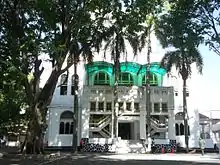Pieter Adriaan Jacobus Moojen
Pieter Adriaan Jacobus "Piet" Moojen (26 June 1879 - 1 April 1955) was a Netherlands-Indies architect, painter and writer. He studied architecture and painting in Antwerp.[2] He lived and worked in the Dutch East Indies from 1903 to 1929.[2] He was one of the first architects to implement Modernism in the Dutch East Indies. Moojen became widely known for his work on the Dutch entry at the Paris Colonial Exposition in 1931.[3] He was active as an architect between 1909 and 1931.[1]
Pieter Adriaan Jacobus Moojen | |
|---|---|
| Born | June 26, 1879 |
| Died | April 1, 1955 (aged 75)[1] |
| Nationality | Dutch |
| Occupation | Architect |
| Buildings | Cirebon Station Cut Mutiah Mosque Kunstkring Art Gallery |
As a member of the Commisie van toesicht op het beheer van het land Menteng, Moojen was influential in designing the town planning for Batavia's Nieuwe Gondangdia garden city (now Menteng). He established the Kunstkring for both Bandung (1904) and Batavia. As a painter he was a member of the Bataviasche Kunstkring and actively participated in exhibitions. Many of his paintings were kept in Amsterdam's Tropenmuseum.[4]
Moojen was interested in Indonesian culture, especially the ancient monuments. His Kunst op Bali (1926) outlined the ancient Balinese architecture.[4]
Moojen was the pioneer of a new building style in the Dutch East Indies. In 1912, civil engineer C.E.J. van der Meyl underscored Moojen's importance to the emergence of Modernism in the Dutch East Indies. Berlage made similar comment in his Mijn Indische reis (Rotterdam 1931). He reasons that in designing the Batavia's NILLMIJ office and Kunstkring Art Gallery, Moojen replaced the customary Classicist forms with "the realization of a more rational concept", an international architectural movement known as Rationalism, which was later dubbed as New Indies Style to refer this movement in the Dutch East Indies where it was slightly conformed to suit the local climate.[5]
Works
Architecture and interior
- Cut Mutiah Mosque, Jakarta
- Cirebon Station, Cirebon
- Hotel der Nederlanden's dining hall, Jakarta (1906)
- Kunstkring Art Gallery, Bandung
- Kunstkring Art Gallery, Jakarta (1914)
- Batavia office of Dutch East Indies Life Insurance and Annuity Company (Nederlandsch-Indische Levensverzekerings en Lijfrente Maatschappij or NILLMIJ) (now head office of Asuransi Jiwasraya)
 Kunstkring Art Gallery, built in 1914.
Kunstkring Art Gallery, built in 1914. A villa in Bandung built by the architecture firm Biezeveld & Moojen
A villa in Bandung built by the architecture firm Biezeveld & Moojen Cirebon Kejaksan Station
Cirebon Kejaksan Station Cut Mutiah Mosque, formerly an office building.
Cut Mutiah Mosque, formerly an office building. Office of Nillmij (Nederlandsch-Indische Levensverzekerings en Lijfrente Maatschappij) in Jakarta, now head office of Asuransi Jiwasraya.
Office of Nillmij (Nederlandsch-Indische Levensverzekerings en Lijfrente Maatschappij) in Jakarta, now head office of Asuransi Jiwasraya.
Painting
- Een prinselijke Javaanse danser (1923)
- Een markt op Bali (unknown year)
Book
- Kunst op Bali: inleidende studie tot de bouwkunst (1926)
See also
References
- "MOOJEN, PIETER ADRIAAN JACOBUS". Art Index (in Dutch). Nederlands Architectuur Instituut. Retrieved January 1, 2014.
- Heuken, Adolf (2001). Menteng: kota taman pertama di Indonesia (in Indonesian). Yayasan Cipta Loka Caraka. p. 20.
- "MOOJEN, PIETER ADRIAAN JACOBUS". NAI (in Dutch). Nederlands Architectuurinstituut / BONAS Collectie Informatie Systeem. Archived from the original on January 2, 2014. Retrieved January 1, 2014.
- "Moojen, PAJ". Ensiklopedi Jakarta. Dinas Komunikasi, Informatika dan Kehumasan Pemprov DKI Jakarta. 2010. Retrieved March 22, 2015.
- Bloembergen, Marieke (2006). Colonial Spectacles: The Netherlands and the Dutch East Indies at the World Exhibitions, 1880-1931. Translated by Beverley Jackson. NUS Press. p. 61. ISBN 9971693305. Retrieved March 21, 2015.